Google Analytics (GA) has become one of the most powerful tools available to marketers across the world. But even though Google Analytics data can provide a significant edge, simply learning how to use the platform can be a challenge. You need to read the basic documentation provided by the platform, but you also need to research expert Google Analytics tips (or get the help from a professional search engine optimization specialist) that help you shorten the learning curve.
With that said, many marketers see GA as a dry and highly technical topic.
Inexperienced individuals may not even know how to properly configure Google Analytics, let alone use it.
But I assure you that the actionable insights that analytics programs (like Google Analytics) give you are well worth your time.
This article will explain how to find hidden keywords, use Google Analytics for search engine optimization (SEO), and move beyond basic capabilities to get the most out of this platform.
We’ll also go over additional tips for Google Analytics users that want to take their GA knowledge to the next level.
Without further ado, let’s go over our top Google Analytics tips.
1. Find Hidden Keywords Using Search Console Data
Typically, keyword research involves using tools like the Google Keyword Planner, Ahrefs, or SEMrush to discover which keywords have search volume and extract data from competitor campaigns.
However, I have found through experience that some keywords have search volume, even though these search results analysis tools claim that they don’t. They are “hidden”.
15% of the keywords that Google sees every year are new, and have never been seen before. So it makes sense that keyword tools wouldn’t show search volume for those terms.
The raw data shows that, oftentimes, these are keywords with time-based modifiers, such as “best blockchain software 2020” or “best dividend stocks october 2020”.
Many times they involve trending events or new things, such as new products, TV shows, or sporting events, so it’s difficult to compare historical traffic trends.
But, this doesn’t mean they are not valuable.
Getting attention or SEO traffic from trendings events is called “newsjacking”. And, besides paid marketing campaigns, you can do it with an SEO approach, too.
You can discover hidden keywords in your niche by following a simple, two-step process:
- Write about trending topics in your industry
- See what related queries have impressions in Search Console (to find out how much traffic you can expect)
It looks like this:
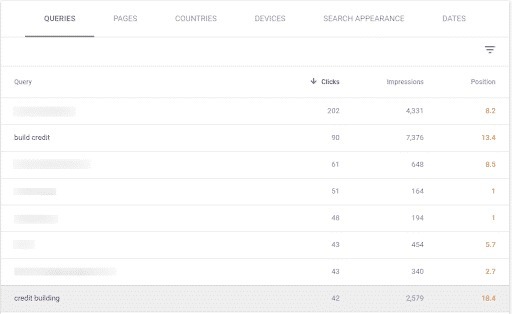
Earlier this year, my team and I were writing a lot of content about the government’s new “ppp loans” and “eidl loans”.
These new programs were trending in the news, and even though the keyword tools showed no search volume for them, we knew exactly what was going to happen.
When I looked in Search Console, I saw our website ranking on the bottom of page 1 and the top of page 2 for related queries, including:
- ppp payroll requirements
- sba emergency loans coronavirus
- eidl loan requirements
- eidl loan calculator
So we wrote new articles targeting each one of these keywords.
And, the new articles drove a ton of traffic!
You can follow this same approach with your website. I call it the “splinter off technique,” which you can then polish off with some conversion optimization strategies.
Find queries that your website is starting to rank for, but not in positions 1-5.
Write separate articles optimized for each of those keywords, pay attention to the intent of the competing pieces, and enjoy increased search results rankings as well as traffic.
- More Helpful Reading: What Is SEO
2. Using Google Analytics for SEO
Most businesses use Google Analytics reports to see how many visitors they attract to a particular blog post or page. But, the platform actually provides a huge amount of in-depth information about SEO traffic, including bounce rate and advanced segments.
I have to confess that I used Google Analytics for a while without using this particular view. And once I learned it, it’s literally what I look at every time I use my analytics or analyze conversion tracking.
On the left-hand menu, click on Acquisition > All Traffic > Channels. In the main dashboard, it lists out all of the marketing channels. Click on “Organic Search”.
This view gives you incomplete keyword data, so click on “Landing Page” in the tiny “Primary Dimension” links area.
Now you will see all the data about landing pages that your website gets organic visitors to.
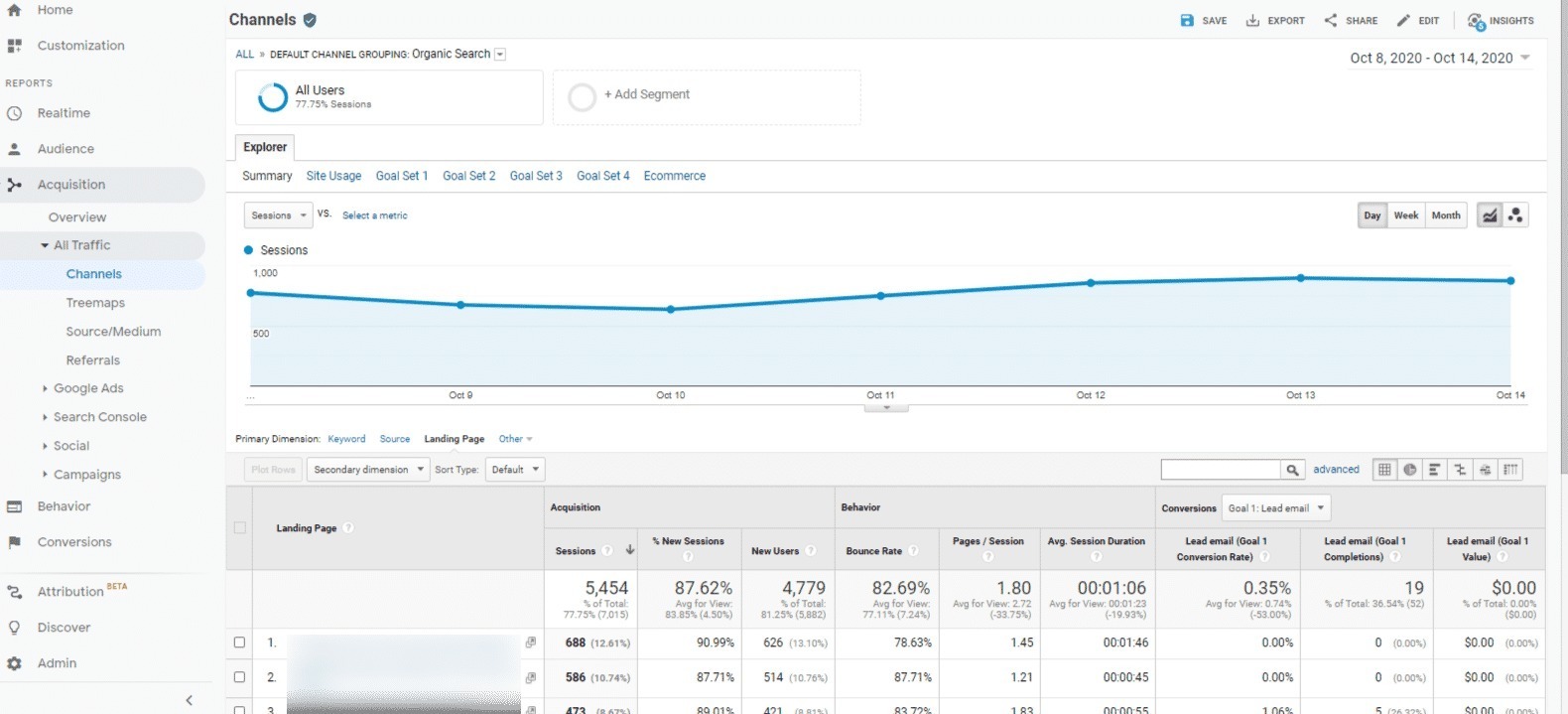
This is where the fun begins.
I like to do what I call a “Pareto Analysis”. The Pareto Principle, otherwise known as the 80/20 rule, states that 80% of your effects are derived from 20% of your causes. Just remember to steer clear from vanity metrics and analyze statistics that reveal valuable information about user interactions on your site.
From this Google Analytics view, ask yourself, “Which 20% of my pages are driving 80% of my traffic?”
You can also see:
- Which 20% of your pages are driving 80% of your conversions, by looking at the conversion data and goals
- Which 20% of your pages are driving 80% of your revenue
The Pareto Principle is widely applicable. Once you use it, you start weeding out irrelevant data and notice patterns everywhere.
Which 20% of your pages receive 80% of the backlinks?
Which 20% of your customers drive 80% of your sales?
Which 20% of your employees achieve 80% of your company’s productivity?
Once you notice the patterns, you can double down on what’s working and ignore the rest. Rinse and repeat.
3. Set Up Alerts in Google Analytics
Besides seeing how many users visited your site, Google Analytics also lets you set up custom alerts to better understand user behavior.
A custom alert is great because it can notify you of important things. You’re not always going to be paying attention to every aspect of your marketing.
When it comes to SEO, I like to set up two types of alerts: for website traffic fluctuations and for content evaluators.
A few years ago, I worked at a company that got hit by a manual penalty on several of the websites that they owned. This is the worst thing that can happen to you in SEO.
Entire site sections were de-indexed. The unpaid search traffic to those web pages dropped off immediately, and that caused a ton of revenue to disappear overnight.
Interestingly, in the case of some of the websites, Google Search Console’s email notifications didn’t go out for several days, or even a week.
And nobody noticed until the emails went out!
Don’t let this happen to you.
While you might not receive a manual penalty from Google, there are other things that could cause your organic search traffic to instantly drop, including:
- Your website getting hacked
- Your bounce rate exponentially increases
- Your server going down
- Somebody disallowing the entire website in the robots.txt
- Setting the homepage meta robots to no-index
- Site speed issues like slow-loading pages
- Compromised data integrity at any point during the connection
I have seen all of the above happen to websites.
So, you need to set up a Google Analytics alert for drastic traffic drops. This will send you an email alert the second your trigger event happens.
To set this up, go to the Admin gear symbol at the bottom of the menu. Click on Custom Alerts, then click the +New Alert button. You can set up various alerts, including when sessions drop below 50% compared to the previous day.
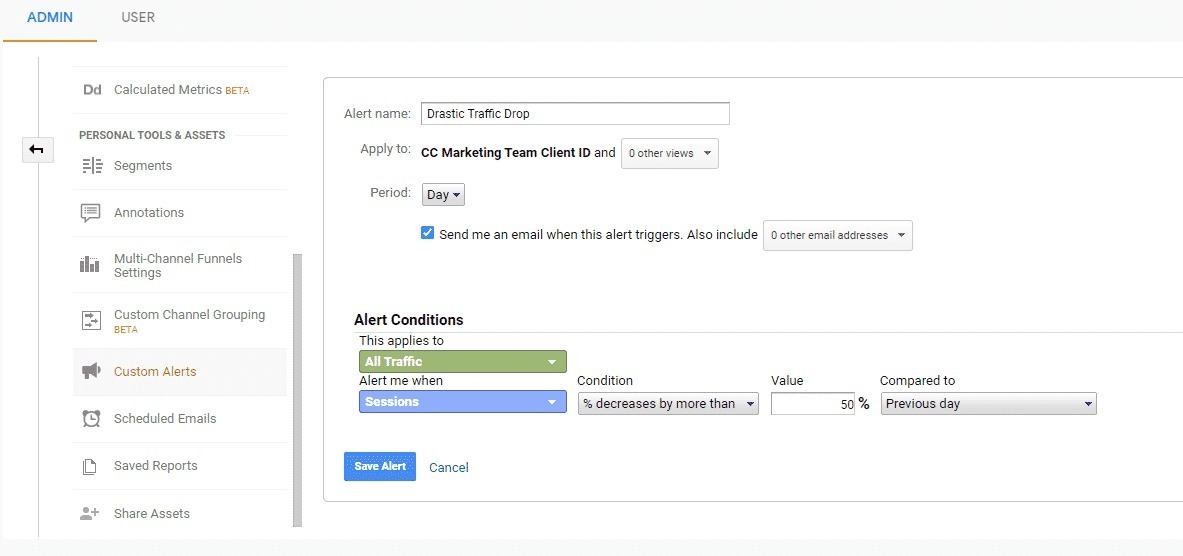
The other alert that I like to run is to see if a manual content evaluator is reviewing the content on my website.
If the content evaluator doesn’t like what they see, they can give a bad review that might result in a massive decrease in organic visitors to that website. Or, if they like what they see, the opposite can happen.
Google officially denies this, but I’ve seen it happen with my own eyes.
Controversial opinions aside, you’ll want to know if you’re receiving a manual content review.
Google Analytics offers the ability to receive notifications through email. So, with this alert, you’ll want to set up an email notification if your website gets referral traffic from any one of the known contractor websites.
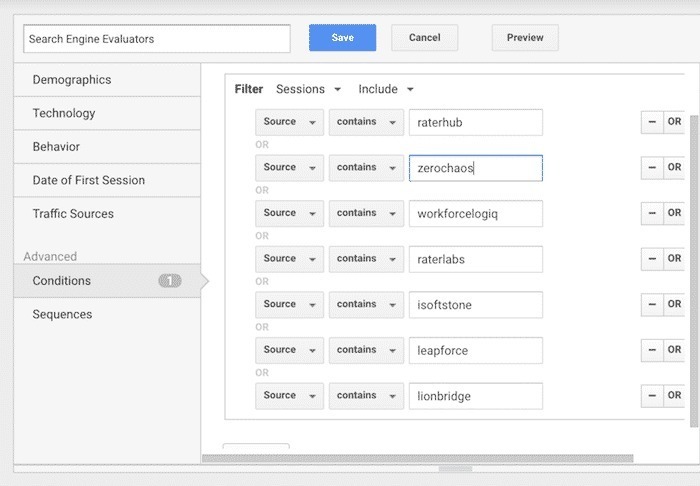
Neil Patel has exact instructions on how to set that up here.
- More Helpful Reading: The Ultimate Guide to Organic SEO
4. Advanced Web Analytics for Boosting Conversions
The free version of Google Analytics has become an industry-standard tool. It’s great, and I use it every day. But it has limitations.
For starters, the data isn’t always 100% accurate. The free version of Google Analytics uses sampled data, so you’re not seeing everything that happens on your website. There is a margin of error on the numbers that you see, which can sometimes be misleading.
Even more importantly, Google Analytics struggles to track users across different devices and products. In other words, it’s hard to get a holistic image of how users interact with your content.
For example, say that someone finds your website through a Facebook ad on their phone. Then they leave your website.
The next day, they Google your company name on their home computer, click on an organic search result, and create an account. The day after that, they come back directly to the website on their work computer and buy something from you.
Google Analytics would probably attribute this event as a conversion event from the “Direct” marketing channel, because the last time the user visited your website they directly typed it into their browser. But, even if you paste the tracking code directly on your site like you’re supposed to, the conversion attribution would not be accurate when you create reports with GA data.
GA wouldn’t put together that the user actually visited your website two times before, on different devices. This can be a problem if you’re running an ecommerce business and want to leverage big data to make decisions.
If you want to blast past those limitations, I would recommend a product analytics tool like Woopra. Like Google Analytics, Woopra also has a free product version, but they:
- Report on 100% of your data
- Connect the same user across multiple devices and touchpoints
- Will even retroactively tie together multiple touchpoints for a single person, acting almost like a CRM
- Page load time data
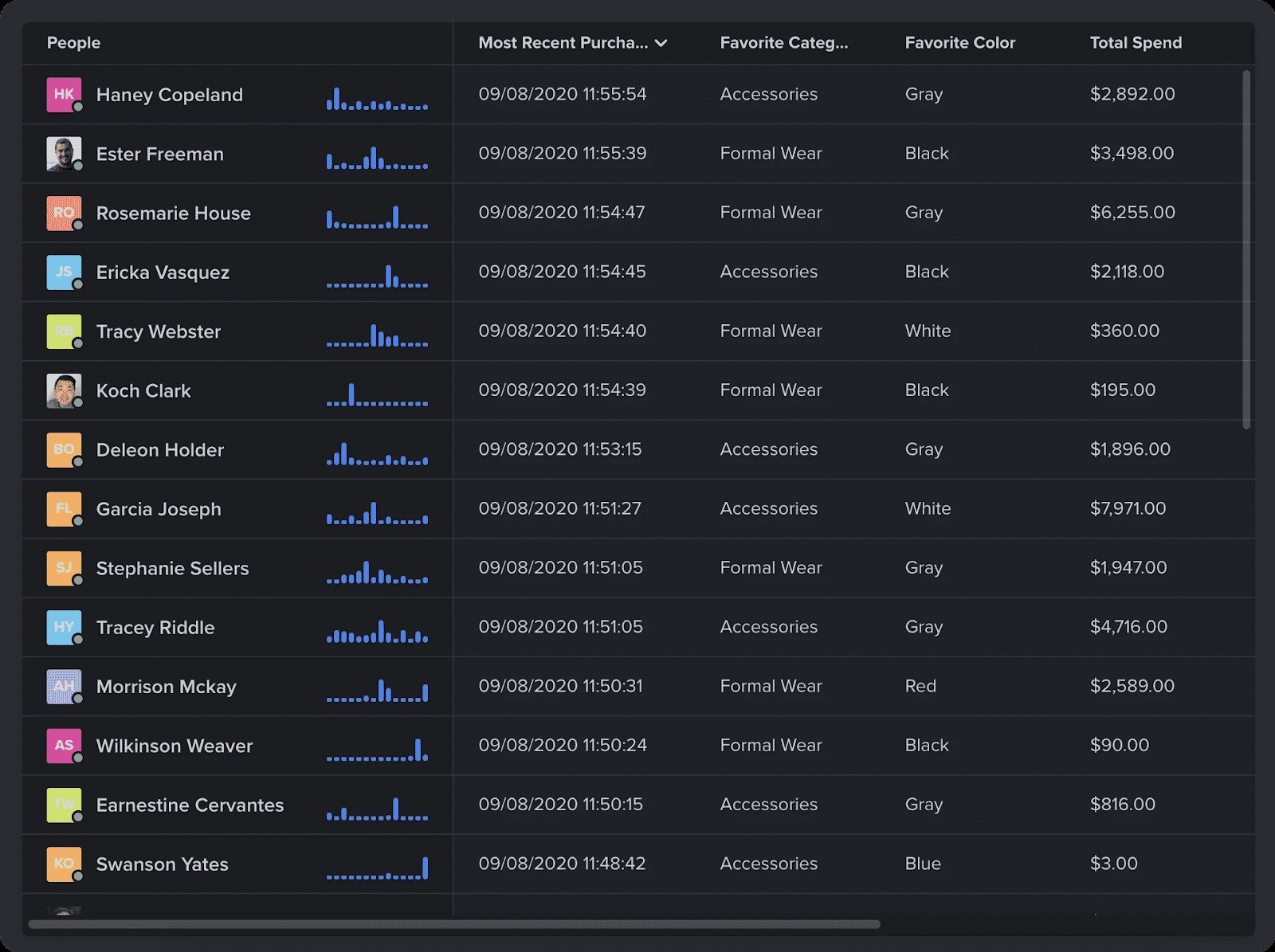
In the example that I mentioned above, Woopra would track all of those touchpoints. Once the user created an account, it would be able to tie together all of the devices that the user logs in with, and track them as a single person.
This is hugely valuable, because now you have accurate data on:
- How many touchpoints your customers actually need before buying from you
- Comprehensive data across multiple devices, whether the user is logged in or logged out
- Correct revenue attribution based that go beyond the last landing pages visited
- More Helpful Reading: How to Rank Higher on Google
5. Analyze Your Backlink Anchor Text
A lot of attention goes to what users type into the search bar, but there are more influential elements that can help you get better rankings. Since backlinks and content are the two most important ranking factors in SEO, they both merit attention and resources.
Figuring out how many backlinks you need to rank for a specific keyword can be tough.
The industry-standard tools, Ahrefs and Majestic, have good insights for this, especially because you can filter data and see information from only one page. But it takes a lot of exporting data and then manual spreadsheet work. It’s time-consuming.
SEOjet is my favorite tool for helping to analyze backlink data. You sync it with your Ahrefs or Majestic account, tell it the keywords that you want to rank for, and let it do the work.
It tells you how many backlinks you will need to rank for each keyword, based on the competitor website data for that keyword. It also tells you what anchor text you need your links to have.
I’ve been able to rank for some highly competitive keywords by rigidly focusing on anchor text ratios and only acquiring high-quality links.
Usually, optimized anchor text ratios look like this:
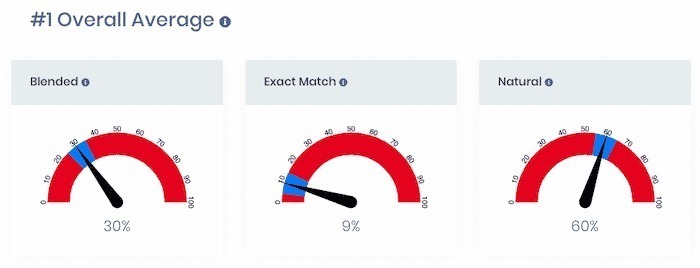
SEOjet splits your anchor text types into three different areas:
- Exact Match
- Blended
- Natural
“Exact match” anchor text is when the anchor text is your keyword.
If you’re trying to rank for “credit scores”, then your anchor text will say “credit scores”.
“Blended” is when you see the keyword words in the anchor text, but they’re not an exact match. For the keyword “credit scores”, examples of blended would include “credit” and “the best credit scores in the whole world”.
“Natural” anchor text is everything else. This includes branded, naked URLs, URL variations, and generic anchor texts. These include:
- Branded – “Fannit Internet Marketing”
- Naked URLs – “https://www.fannit.com/”
- URL variations – “Fannit.com”
- Generic – anything without the keyword, brand, or URL, like “click here” or “this website”
When you get into the weeds of anchor text analysis, you’ll see variations of all of the above, and other things besides.
The important rule of thumb to remember is to: use exact match anchor text sparingly, and be liberal with your use of branded anchor text.
The former CEO and Executive Chairman of the Board of Google, Eric Schmidt, has publicly stated that, “Brands are the solution, not the problem… Brands are how you sort out the cesspool.”
This reflects an underlying belief from Google’s top brass.
They believe that what separates spam websites on the internet from legitimate enterprises is the existence of a brand.
I believe that’s why Google has emphasized brand signals as an important part of its ranking algorithm.
Google likes to see:
- Branded anchor text to your homepage
- Lots of links in general to your homepage
- Branded anchor text to your inner pages
- Non-link mentions of your brand name across the internet
Using this methodology, you can outrank competitors with stronger domains and bigger budgets.
6. Additional Tips and Tricks
While the suggestions above are somewhat technical, I’ve also put together a few basic tips for Google Analytics.
New Bloggers, webmasters, and other beginners can look at this section to find Google Analytics uses and tips for first-timers.
Besides SEO and organic traffic tips, we’ll also discuss Analytics tips tricks for Google Ads (formerly Google Adwords) as well as details on how to create custom segments.
Let’s take a look at Google Analytics tips for better
Sync Google Search Console (GSC) Data
No list of Google Analytics improvement tips is complete without covering the GSC.
Along with GA, the GSC provides a holistic view from a rankings as well as a user experience perspective. Therefore, you need to ensure that your GSC account and Google Analytics account are synced properly.
Once you complete the linking process, you should have new features and a richer data set available.
GSC gives you the ability to see which keywords you’re ranking for, which pieces of content attract the most traffic, and what positions your pages are positioned in.
You can even organize page performance by CTR, total number of clicks, and many other variables.
Create SEO Goals
Though it may seem basic, creating SEO goals is one of the best Google Analytics tips you’ll ever hear.
If you haven’t already, you should create a set of SEO goals and tie them directly to specific pages on your site.
If you don’t have a page that’s perfectly suitable for a specific goal, the best alternative is to create a customized version that’s designed for optimal performance.
For example, if you want to attract leads, you should create a page that prominently features a form or lead magnet.
Also, remember to look beyond organic traffic totals and CTRs.
Instead, monitor statistics that unveil actionable data, like conversion rates, time spent on page, and number of pages visited per session.
Just remember that you’ll want to compare the results of your SEO performance with social media, PPC, and other parts of your marketing campaign, so be as accurate as possible when analyzing the numbers.
Compare Organic and Paid Traffic
It’s true that a large portion of our Google Analytics tips for business owners are about SEO and organic marketing as a whole.
But, GA can also be used to monitor paid campaigns, including PPC ads as well as social media ads.
That said, remember that you need to filter out invalid traffic from the organic metrics you collect, for example, crawlers and other types of bots.
Once you can ensure that the organic data is accurate, it’s time to compare and contrast.
By default, GA shows all of the data collected by its tracker. So, run a filter to only show organic visitors and review the pages that are delivering the best results.
Now, filter out organic traffic and analyze paid results to see how it stacks up.
If the performance from your ads is much better, try to identify the sources and techniques being used in case they can be applied to your organic campaign, and vice versa.
- More Helpful Reading: Website Traffic
Identify Your Best Content
Google Analytics allows you to create custom reports of all types, including landing page performance reviews.
A landing pages report includes all of the information about the performance of a specific page, so you can finetune the parts of your site that are already performing well.
At the same time, you can also use these customized reports to see which pages have a high bounce rate and identify potential areas of improvement.
Keep in mind that the way visitors interact with the content on your landing pages can also unveil a huge amount of data about user behavior.
But, one of the few things that GA can’t do is provide a heatmap that tells you where users spend most of their time on your site. So, as a pro Google Analytics tip, you should consider getting Hotjar or a similar solution installed on your pages.
See Which Landing Pages Produce the Best Results
The written content is crucial, but the performance of a page depends on more than the text it contains.
Fortunately, GA allows you to view a variety of elements that impact page performance, from loading speed to the keywords that users searched for before entering your site.
Likewise, you can also see which posts and pages are attracting the most traffic by generating a historic or real-time report.
This is one of the best Google Analytics tips for bloggers because, in most platforms, a few articles are responsible for driving most of the external and internal traffic.
If you can identify these pages, you’ll be able to optimize them, improve their performance, and mimic a similar strategy in the rest of your site.
Track Content Updates Through Annotations
Many Google Analytics users are not aware of annotations or what they allow you to do, but they are among the top features found in GA — even if they are deceptively simple.
Boosting SEO traffic is a gradual process and many marketers struggle to keep track of the performance of the campaigns.
By leaving annotations on specific dates on GA, you can create notes that remind you of specific events or actions you took to boost the performance of a page.
Even though it may not be considered one of the top Google analytics pro tips for some, getting used to leaving annotations can simplify the tracking and optimization process later on.

Learn How to Use the Multi-Channel Funnel Report
Google Analytics funnel tips are hard to come by because this feature is best left to advanced users.
By accessing the funnel section in your Google Analytics account, you’ll be able to track buyer journeys and break down user groups by segment.
At the same time, users can also use multi-channel funnel strategies by creating custom segments based on the different personas they target.
With that said, remember that users behave differently on distinct platforms, but they are still the same users.
Therefore, you should use multi-channel funnel reports to understand the nuances between the sessions that a user enters your site via paid channels versus organic means.
Discover New Referral Opportunities
As you probably know already, SEO success relies on both off-page and on-page variables.
For example, linking building has been one of the most important elements of SEO since its early days.
The problem is, many businesses struggle to find quality off-page opportunities to boost traffic and SEO.
The good news is that the Google Analytics data you collect contains a referrals section, which shows inbound links that are not usually displayed in other tracking platforms as well as potential opportunities you can seek out.
View and Compare Your PPC and SEO Expenses
Many GA users generate custom reports to compare the performance of their Google Ads and organic campaigns. However, comparing the cost of your SEO and PPC campaigns is equally important because this will tell you which one of the two is more profitable.
It’s true that PPC requires a direct investment, but if the ROI is high enough, it can actually be a more profitable tactic than SEO.
That said, you should always work on improving your organic marketing in order to replace paid ads with unpaid strategies.
This will help you reduce costs while maintaining the same performance in the long run.
Understand How Google Sees Your Industry
It’s no secret that Google Analytics provides comprehensive data about your site, but it also reveals a huge amount of information on your industry.
This is crucial because Google categorizes all pages, so being updated with the most recent trends means that your site will remain a leading authoritative figure in your space.
You can see how Google categorizes your site as well as different industry trends by looking in the Audience tab.
Here, you can see affinity category and in-market segment metrics, which give you an idea of who you are reading and how your site is categorized respectively.
Customize the Dashboard
If you’ve researched Google Analytics dashboard tips before, you know that you can tailor this part of your account based on your unique requirements.
Your custom dashboards can be adjusted depending on the most crucial metrics you need to monitor. You can also add a secondary dimension as well as additional metrics like bounce rate to give you a more wholesome view.
The secondary dimension on your dashboard can be a specific metric as well as a date range.
So, your dashboard can be adjusted to show you specific metrics like conversion rate or bounce rate that were collected over a specific date range, say, the last two weeks.
Bonus Google Analytics Tips and Best Practices You Can Leverage for Better Blog Post Performance
We’ve covered beginner Google Analytics tips as well as tricks for advanced users — but we still have plenty more to share!
In this section, we’ll create a Google Analytics tip list designed specifically for bloggers and website managers.
Note that blogs don’t necessarily have to be attached to a conventional business to generate revenues.
As long as you track your conversion rate, keep your bounce rate under acceptable levels, develop quality content, and follow each Google Analytics tip below, you should be able to set up a site with affiliate links or a similar platform.
Let’s take a look at our blogger Google Analytics tip list.

Don’t Check Stats for the Sake of It
Although it feels like being more active on Google Analytics will help boost the performance of your site, this isn’t the same.
So, instead of running dozens of reports that only show gradual progress, you should avoid checking your stats unless you have a really good reason.
If you’re not optimizing your campaign or monitoring your campaign (within reason), there aren’t many reasons why you should go into your GA account. And, if you are performing an optimization or similar action, make sure to adhere to the list of tasks you need to complete.
Have Your Reports Emailed to You
One of the most important tips for using Google Analytics is to have your reports emailed to you.
It can take a few hours to generate reports on the platform and many marketers fail to take advantage of the time they have available and simply wait until GA is done.
Instead, you should focus your efforts on actions that improve conversion rate, reduce bounce rate, and produce a better overall user experience.
See the Real Page Conversion Rate
The conversion rate of your site tells you how many leads or conversions you’re generating.
But, this metric can be misleading, especially if your GA account is not set up properly.
Moreover, the overall conversion rate of most sites sits below 3%, which isn’t anything to brag about if you look at it objectively.
Even worse, because GA counts visitors from all channels, conversion rate metrics can be misleading even if everything else is properly in place.
Fortunately, the solution is within Google Analytics itself.
GA users can filter out visitors based on specific details. For example, you can exclude visitors that hit the back button before the page content actually loads.
By identifying the visitors that destroy the integrity of your data and filtering out these users, you can improve the accuracy of your data.
Make Use of the On-Site Search Terms Report
Have you ever accessed a website that didn’t have a great structure, but you wanted to browse through anyway?
In these cases, having a site search feature can greatly improve site navigation and usability.
But, even though many users leverage site search bars, not all marketers take advantage of the data this feature provides.
GA allows you to see which queries were conducted through the site search feature on your site.
This is a hidden goldmine because it reveals a huge amount of information about your potential customers, how they perform searches, and what pages they want to see on your site.

Learn Shortcuts to the Commands You Use Most
It may seem trivial because this concept applies to any computer task, but most people waste a huge amount of time scrolling, looking for features, and clicking on the right buttons.
As with most other marketing tools, Google Analytics has shortcuts that allow you to adjust date range settings, display detailed information, and complete additional tasks without having to scroll or move the cursor at all.
If you take the time to master these shortcuts, you will save a substantial amount of time that you can reinvest into developing better campaign content.
Guarantee a Smooth Flow By Studying Your Target Audience
Yes, you probably have a huge amount of knowledge about your audience already, but you should still take the time to analyze your traffic as well as general consumer trends.
This can unveil valuable information that you can use during the content creation and optimization processes.
You can even compare behavior by date range, for example, analyze holiday performance during the previous years in order to make adjustments that keep bounce rate low.
Analyze and Improve Site Speed
We’ve touched on site speed a few times during this article, and even though this Google Analytics tip seems obvious, we need to go over it one more time just to emphasize how important it is.
Site speed affects all areas of your digital strategy, including SEO, PPC, social media, and email campaign performance.
It even has a direct impact on bounce rate, so make sure that your pages load as quickly as possible. The golden rule is that your site should load in 5 seconds or less, preferably 1 or 2.
- More Helpful Reading: Google PageSpeed Insights: Definition, Developers Insights
Understand Conversions Through Attribution Reports
If you’re looking for Google Analytics attribution tips, you’ve come to the right place.
The attribution report on GA tells you where each visitor and conversion is coming from.
But, GA may not be smart enough to understand that some attributions go beyond the last point of contact, especially if you don’t haven’t linked the Search Console yet.
Generate and Analyze Assisted Conversion Reports
Assisted conversion reporting is a sub-feature found in the multi-channel funnels tab on GA.
It allows you to see conversions that your site was involved with, but was not the final touch-point before the lead or sale was generated.
You can also see direct conversions that are accredited to your site, which means that your page was the final point of contact before the interaction.
Develop Strategies By Reverse-Engineering Conversions
A lot of business owners want to follow a logical path when mapping out buyer journeys.
The issue is that the early stages of the buyer’s journey present a wide range of variables.
To avoid this issue, you can take a distinct approach and attempt to reverse-engineer conversions after they have occurred.
In other words, look at your leads and sales, then attempt to backtrack on the steps they took before they completed each respective interaction.
Dissect New and Returning User Behavior
Not only do users change the way they behave on different devices, but the same is true for returning and new users.
This is one of the best Google Analytics segment tips and tricks out there because most companies assume that returning visitors fall right back into the same part of the funnel, when this isn’t always the case.
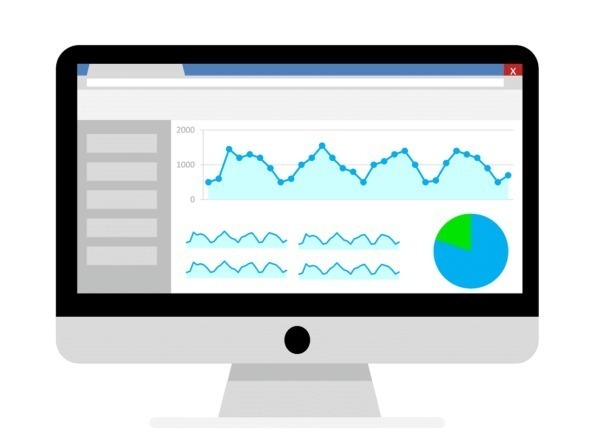
See What Customers Are Into Through Affinity Categories
We mentioned the affinity category briefly in this post, but it’s worth noting that this powerful feature can reveal what topics your website users are interested in.
This will help you generate content that engages visitors and resonates with these potential customers.
Need Help with Your Google Analytics? Fannit Is Here to Help
There is a lot to unpack in the Google analytics basic tips listed above.
The important thing is to get started, move forward, and learn and do more today than you did yesterday.
If you need assistance with your Google Analytics management process or other areas of your digital marketing strategy, contact us today and we’ll be glad to help.
Recommended Article: Consent Mode in Google Tag Manager – What You Need to Know